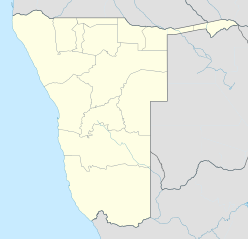| Roter Kamm crater | |
|---|---|
 Roter Kamm, aerial view direction south (April 2017) | |
| Impact crater/structure | |
| Confidence | Confirmed |
| Diameter | 2.5 km (1.6 mi) |
| Age | 4.81 ± 0.5 Ma Zanclean |
| Exposed | Yes |
| Drilled | No |
| Location | |
| Location | Sperrgebiet, Namib Desert |
| Coordinates | 27°46′0″S 16°17′20″E / 27.76667°S 16.28889°E |
| Country | Namibia |
| State | ǁKaras Region |
Roter Kamm (German: Red Ridge) is a meteorite crater, located in the Sperrgebiet, within the Namibian section of the Namib Desert, approximately 80 kilometres (50 mi) north of Oranjemund and 12 kilometres (7.5 mi) southwest of Aurus Mountain in the ǁKaras Region. The crater is 2.5 kilometres (1.6 mi) in diameter and is 130 metres (430 ft) deep. The age is estimated at 4.81 ± 0.5 Ma, placing it in the Pliocene.[1] The crater is exposed at the surface, but its original floor is covered by sand deposits at least 100 metres (330 ft) thick.







